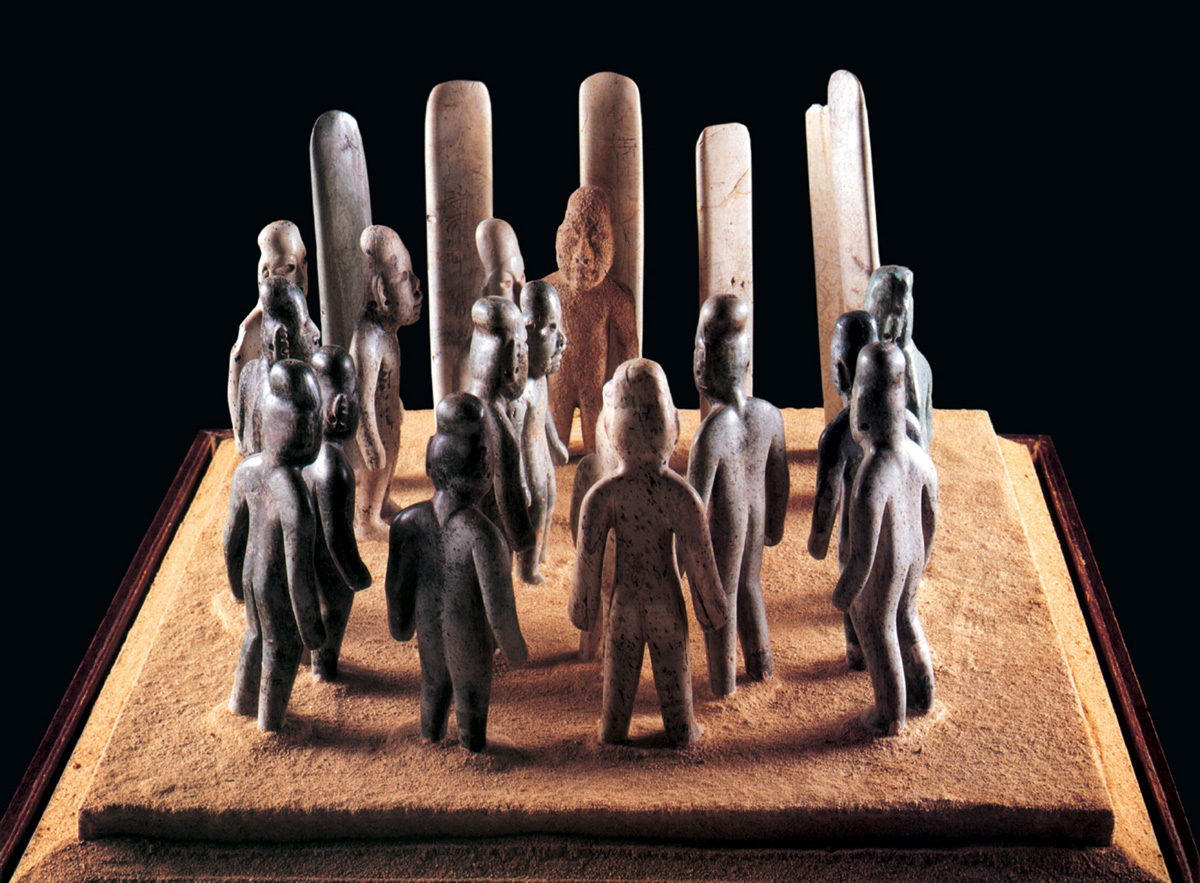Offering For
The Olmec and the mysterious case of Number 7
James Oles

“This offering came to light in the late afternoon just before the regular shift ended,” states the report of the 1955 excavations at the Olmec site of La Venta, in the Mexican state of Tabasco, then as now, surrounded by Pemex oilfields. The discovery by three American archaeologists from University of California Berkeley (including Robert F. Heizer, whose son would eventually do some earthworks of his own), prompted a hurried excavation for fear of looting.
Offering 4, as it was named, consists of sixteen male figures between fifteen and twenty centimeters in height: thirteen in serpentine, two in jadeite, and one of a buff-colored conglomerate of granitic sand. The figures were probably made separately, perhaps elsewhere, and their little mise-en-scène assembled at La Venta sometime between 800 and 500 B.C.
The strange sandy figure, numbered 7 by the archaeologists, was placed with his back against a row of six jadeite celts, ritual axe blades that here seem architectural more than agricultural. The twenty-two elements of this ancient installation were set into reddish-brown sand, then ritually buried with white sand beneath a banded floor of other colored sands. At a later date (it could have been a month or a millennium), someone cut through the banded floor and dug down as far as the heads of the figurines, then refilled the hole. There is inconclusive evidence that another statue standing in front of the celts was removed at this time.
The Olmec lapidaries would have recognized the material used for Number 7 as inferior in quality and color; this distinction has become even more exaggerated now that his once polished surface has been left pitted by the acidic soils of the humid Gulf Coast. But what if that gritty conglomerate was not a sign of inferiority, but rather a badge of distinction, the stone brought from somewhere particularly sacred? The figure stood apart, physically and materially, from the others, but whether he is ostracized or privileged, remains debatable.
While Offering 4 clearly seems to refer to a narrative, its meaning is completely lost. Heizer et al. initially concluded that the figures made of superior materials were staring down an inferior, but closer inspection showed that not everyone was looking at Number 7 after all. In their report, all they could say with certainty was that he was probably a “captive or important personage” observing a ritual, which pretty much covered their bets.
And then there is the other narrative. Why the subsequent need to go back and look? Did the rulers of La Venta feel unsure of their memory of the offering? Did they just want to make sure that things were still in their rightful place, inspecting the lot as if looking into a safe deposit box? Or was someone out to grab a relic from the past? Given our scant knowledge of this object and Olmec culture in general (we don’t even know what the Olmec called themselves), the enigma of Number 7 triggers insecurity in the interpreter, observing the scene, his own back to the wall.
Elizabeth P. Benson and Beatriz de la Fuente, eds. Olmec Art of Ancient Mexico (Washington, D.C.: National Gallery of Art, 1996).
Philip Drucker, Robert F. Heizer and Robert J. Squier, Excavations at La Venta, Tabasco, 1955, Bulletin 170, Bureau of American Ethnology (Washington, D.C.: Smithsonian Institution, 1959).
James Oles writes mainly on modern Mexican art. He splits his time between Mexico City and Wellesley College, where he teaches in the Art Department and is adjunct curator of Latin American art at the Davis Museum and Cultural Center.
Spotted an error? Email us at corrections at cabinetmagazine dot org.
If you’ve enjoyed the free articles that we offer on our site, please consider subscribing to our nonprofit magazine. You get twelve online issues and unlimited access to all our archives.